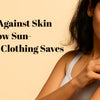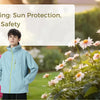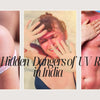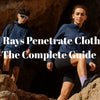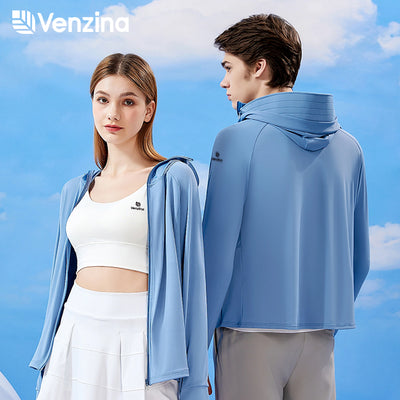Do UV Rays Penetrate Clothes?—The Complete Guide
- by IN Venzina

Wearing clothes specially designed for sun protection is very important for outdoor activities, as everyone is increasingly exposed to the sun. Most people assume that wearing clothes will protect them from the sun, but this is wrong. The burning question is, do UV rays penetrate fabrics? And the answer is indeed light, loose-woven, or wet clothing. Everyday clothes like white T-shirts may allow as much as 80% of harmful rays to penetrate through the fabric. Due to the fact that a lack of clothing is harmful to people’s health, designers should also focus on making clothes that are easy to wear and provide protection for the skin. Venzina now provides sun-smart apparel made from top-quality fabrics and has been tested for UV defense. Now you can wear clothes that safeguard you from UV rays.
Understanding UV Rays and Their Effects on Skin
Both UVA and UVB rays can cause serious skin damage. While UVA rays accelerate the aging process and penetrate the skin deeply, UVB rays inflict harm on the outer skin layer, resulting in burns and elevating the chances of cancer. As stated by the WHO and SkinCancer.org, the UV rays' effect includes cellular harm, skin pigmentation, and immune suppression. Hence, daily protection is vital. Both types of UV rays inflict skin damage, some of which is visible, while other types of damage are not observable. Over time, skin damage from UV rays has worsened the state of skin, and UV rays have increased the aging effect on skin. Knowing the effects UV rays have on skin helps in choosing the right kind of fabric and protection needed from the sun.
Are UV Rays Harmful to Humans?
UV rays pose a serious threat, especially in countries like India, where exposure to the sun is a lot and the intensity is high. Sunburn and heat rashes are some of the short-term effects, while early aging, pigmentation, and a heightened risk of cancer are some of the long-term effects. The harmful effects of UV rays are most severe during peak sun hours and are most serious for sensitive skin. It is important to emphasize that sun protection is a must. Venzina creates UV-blocking garments that protect against both UVA and UVB rays. Venzina helps one stay stylish while protected from the sun and cool.
Do Clothes Block UV Rays?
Not all clothing guarantees real protection from UV rays. Many garments permit more sunlight to seep through than individuals realize. The question of whether UV rays penetrate clothes can be answered affirmatively. Even bulkier clothing may not offer adequate UV protection without testing. The weave, color, and even dampness of the fabric all impact the amount of sunlight that reaches your skin. Research indicates that ordinary T-shirts allow more than 50% of UV rays to penetrate. On the other hand, garments with a specific rating for protection, like UPF. That guarantees to obstruct 98% or more of the rays.
What Factors Affect UV Protection in Clothing?

The level of UV protection a garment provides is determined by its type, color, and physical state. Dark polyester and nylon materials outperform cotton and rayon in terms of UV resistance. In contrast, loose-fitting clothing protects better than tight garments. Clothing that is wet compromises UV protection, allowing greater exposure to sunlight. These elements describe the real-life effectiveness of clothing in blocking UV rays. Venzina beautifully designs and scientifically protects its garments with UPF-rated fabrics to ensure faithful and stunning sun safety.
What Is UPF, and How Does It Work?
UPF, or Ultraviolet Protection Factor, is defined as the measurement of exposure to sunlight that can get to the skin through clothing. Compared to SPF, which is limited to UVB rays and counts for a topical application, UPF/Shields clothing protects against both types of ultraviolet radiation. A garment rated 15 UPF shields approximately 93% of rays, 30 UPF shields 97%, and 50+ shields 98% or more. The tested garment’s protective capabilities surpass the daily exposure protection required but complement its claim. Venzina UPF-certified clothing is gaining popularity for offering stylish wear with tested sun safety. Venzina’s UPF 50+ collection provides tested, breathable, stylish garments that shield the sun in every outfit.
Comparing UV Protection—Regular vs. UPF Clothing

Some UV protection is better than none at all, but not all fabrics protect equally. A dry cotton shirt only protects against 10% of UV rays, which diminishes to 5% when wet. Linen fabrics are better than cotton, providing 20% protection, while dark denim is the champion at 98% protection. Activewear made of polyester provides decent protection, but only for tight-fitting styles. 98% protection is only obtained for clothing made to specific standards, such as UPF50. Wearing ordinary clothing, especially that made of fabrics without specific UPF ratings, would offer no protection at all. Venzina’s garments, designed to protect against solar radiation with UPF testing, outperform standard options with ease. Venzina’s garments are not only soft, breathable, and stylish for daily wear, but also protective and comfortable to wear during sunny days.
Does Wet Clothing Reduce UV Protection?
Indeed, wet clothing diminishes protection from UV rays. The wetness loosens the fibrils of the woven clothing, permitting greater UV rays to penetrate the clothing. An example of this is a white dry t-shirt’s UPF of 15, which can drop to 5 when wet; hence, 95% of UV radiation can penetrate the skin. It is particularly dangerous to wear wet clothes in the sun, which is common in humid or heavily watered areas. It is important to select apparel that remains protective even when moist. Venzina’s apparel is designed with dry, dense, quick-drying fabrics that hold their protective UPF rating, thereby showering you with protection when you are sweaty, wet, or exposed to the sun.
Practical Sun Protection Tips with Clothing

The best methods of sun protection begin with smart clothing. To minimize UV radiation, use long-sleeved shirts. Try tightly woven fabrics. That offers better coverage. For more comprehensive protection, wear verified garments. Combining clothing with sunscreen, wide-brimmed hats, and sunglasses provides additional sun protection. To minimize skin damage, avoid direct sunlight during peak UV times of 10 am to 4 pm. With Venzina, you will get blended custom protection.
What You Need to Remember
Regular garments often permit UV rays to pass through, particularly light, thin, or wet fabrics. Over time, most daily clothes can result in invisible sun damage. Proven and reliable UPF-rated garments block over 98% of harmful rays, ensuring skin protection. In the current climate, sun-smart fashion is essential.
Semantically Relevant FAQ Questions
What is the best clothing for sun protection?
The most effective type of sun-protective clothing is loose, dark-colored clothing that is woven tightly and has a UPF rating. Venzina’s apparel protects up to a stylish and sporty UPF50+, which is high-performance Venzina apparel that can be worn daily and provides protection under all sun exposure conditions.
How does UPF clothing work?
Specially woven and UV-resistant textile materials that block both UVA and UVB rays are used for manufacturing UPF clothing. The protective capability of the garment increases with a higher rating. Venzina UPF50+ garments are tried and tested to block 98% or more of UV radiation, and both types of UV rays are fully mitigated for 98.5% with Venzina apparel.
Are UPF clothes better than sunscreen?
The protection offered by UPF clothing is uninterrupted and does not require any form of reapplication for the duration of the clothing being worn. The same logic for apparel worn and exposed to sunscreen would be intact, with Sapphire Venzina touted for being dependable and not requiring reapplication of sun-protective clothing. Regarding the application of wet clothing, when fabric becomes wet, sun-protective properties are reduced due to a decrease in size and density.
Does wet clothing offer UV protection?
The loss of garments does not equate to a loss of UV protection. Woven, thin, and loosely made fabrics that are light in weight enable easy penetration of UV rays. Only clothing with a UPF label guarantees effective protection. Venzina’s swimsuits for the first sun rays and daily exposure are specially made for daily sun exposure, thereby protecting the wearer.
Are all clothes naturally UV protective?
Some fabrics do not protect against ultraviolet radiation. The lightweight, thin, or loosely woven materials offer little resistance against ultraviolet rays. Only clothing specifically labeled with a UPF rating offers protection. Venzina’s certified sunwear offers clothing specifically made to protect skin from everyday sun exposure.
Do tight clothes protect better from the sun?
The type of clothing labeled as tight is usually worn, making less skin-covered areas more susceptible to exposure to sun rays. Loosely fitting clothing maintains a tighter weave of the fabric and offers better protection. Venzina makes certified sunwear that is stylish and breathable, yet offers comfort and maximized protection.
Is sun protection needed on cloudy days?
Venzina clothing offers a guarantee of protection against all exposure to the sun; as stated, tight clothing offers up to 80% protection against exposure to skin regardless of the weather, as sun protection is either a comfort-worn UPF clothing or a style.

